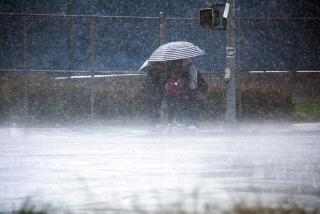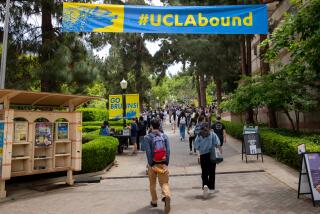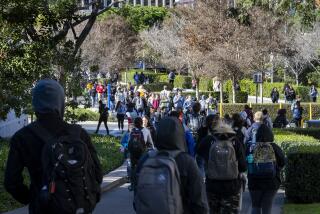L.A. County issues strict rules for colleges reopening during coronavirus crisis
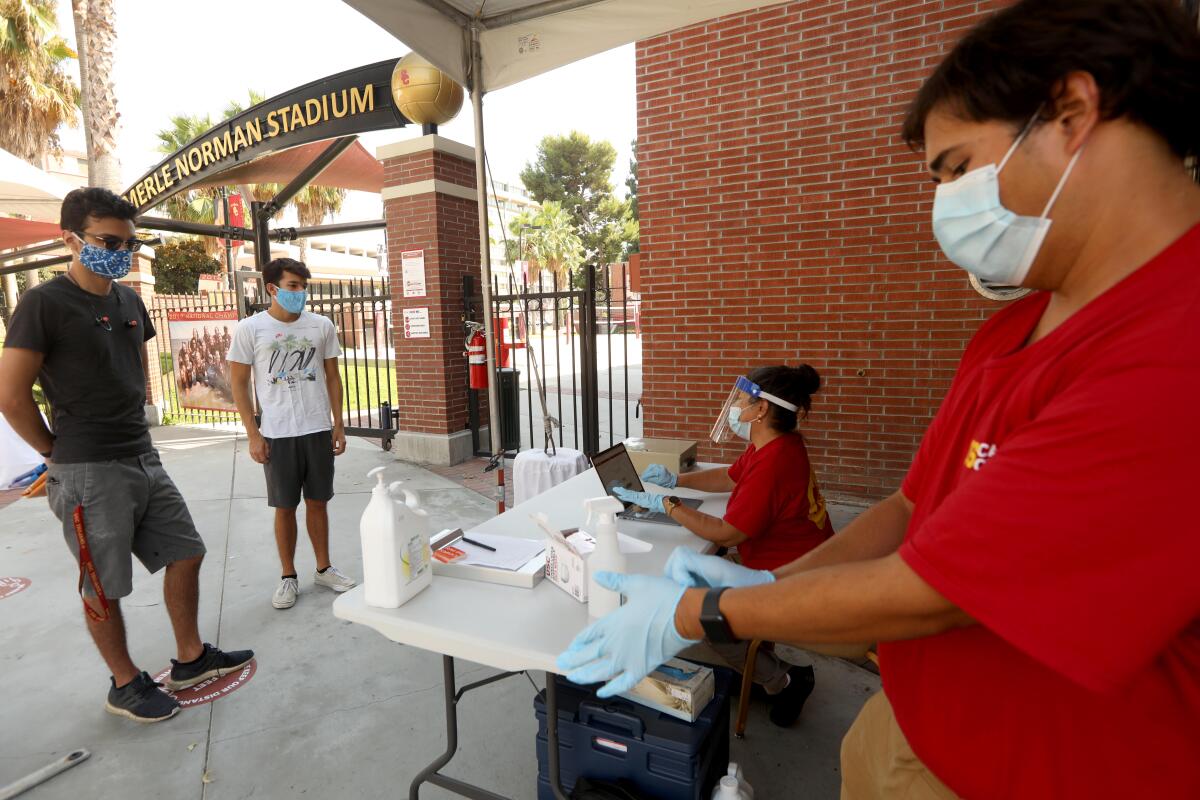
- Share via
As colleges begin their fall semesters, those in Los Angeles County finally received long-awaited public health rules about reopening plans — and they’re more stringent than state guidance: Virtually no in-person classes are allowed, and on-campus housing will be extremely limited due to coronavirus concerns.
The Los Angeles County Public Health rules supersede state guidelines and are tougher than those of many other counties. They are quashing more expansive plans envisioned by Harvey Mudd College and other local campuses and are spurring UCLA officials to reevaluate their own September reopening plans.
USC, which started the fall term Monday, moved from an initial hybrid plan to a more limited one as COVID-19 cases surged but still had hoped to offer on-campus housing to more students and as many as 20% of classes in person. The university said it would limit on-campus housing to about 700 students who had needed it since the pandemic forced colleges to shift to remote learning in March. Most of them are international students, but Catherine Amein, a fourth-year student in electrical and computer engineering, was granted housing for medical reasons.
Amein, who flew back to Los Angeles from Florida on Monday, said she was thrilled to return to campus and was hoping that some of her labs, which have been moved to remote instruction for now, would eventually open for in-person meetings.
The county Health Department says in a statement that colleges and universities need to limit campus activities in the near term because high community transmission rates are driven, in part, by younger people ages 18 to 30 years old who currently account for 25% to 30% of new infections.

“I know that our decision to delay fully reopening colleges and universities is disheartening news for our students who were looking forward to life on campus,” county Public Health Director Barbara Ferrer said. “But this postponement means that we will continue to slow the spread of COVID-19 and get to the point where we can return to campus when rates of community transmission are lower.
“The very nature of the way that colleges and universities operate creates a significant risk of outbreaks of COVID-19 among students, faculty and staff,” she added. “And these risks extend beyond campus into the broader community. That is why we have made the difficult but necessary decision to limit the reopening of these important institutions.”
The new county guidelines are likely to create more financial woes for UCLA as they allow only students with no “feasible alternative” to live in campus housing, which must be limited to single occupants. The Westwood campus had hoped to house as many as 1,500 students in double-occupancy apartments.
UCLA also planned to offer about 8% of classes in person, including some that involve laboratory work, performing arts and clinical health fields. The county guidelines, however, reiterated that only classes that involved training for “essential workforce” needs, such as public health, emergency services, food, energy and transportation, could be offered in person.
A UCLA spokesman said the university was “actively reviewing the protocols” but could not yet elaborate on how the county rules would affect its reopening plan. UCLA does not start its fall quarter until Sept. 28; if public health conditions improve by then, county officials may relax the rules.
Harvey Mudd, the only one of the five undergraduate Claremont Colleges that still held out hope for an in-person return to campus, announced Friday it would go fully remote following the county announcement last week. Harvey Mudd President Maria Klawe said she asked county officials for a waiver, presenting what she said was a careful plan she believed would keep students safe, but failed to win them over.
“We’re disappointed,” Klawe said in an interview Monday. “Of course, I wish they had done something different, but I’m not going to criticize them because the reality is people are dying. A lot of people are still not taking masks and social distancing seriously, and they’re really trying to get a grip on it.”

Harvey Mudd had expected nearly 500 students among about 835 enrolling for fall to return to campus housing. The shutdown of dorms will cost Harvey Mudd $12.3 million in room and board, contributing to a budget shortfall the college addressed in part by furloughing 71 of 247 employees, Klawe said. Other campuses also face steep declines in housing and dining revenue, including the University of California and California State University systems.
UC campuses lost $310 million in March alone for canceled housing and dining contracts, facility cleaning costs and transitioning to remote instruction.
By June 30, UC was hit by nearly $1.8 billion in lost revenue and new costs related to the pandemic, which was only partly offset by nearly $800 million in federal funding, then-UC President Janet Napolitano said last month.
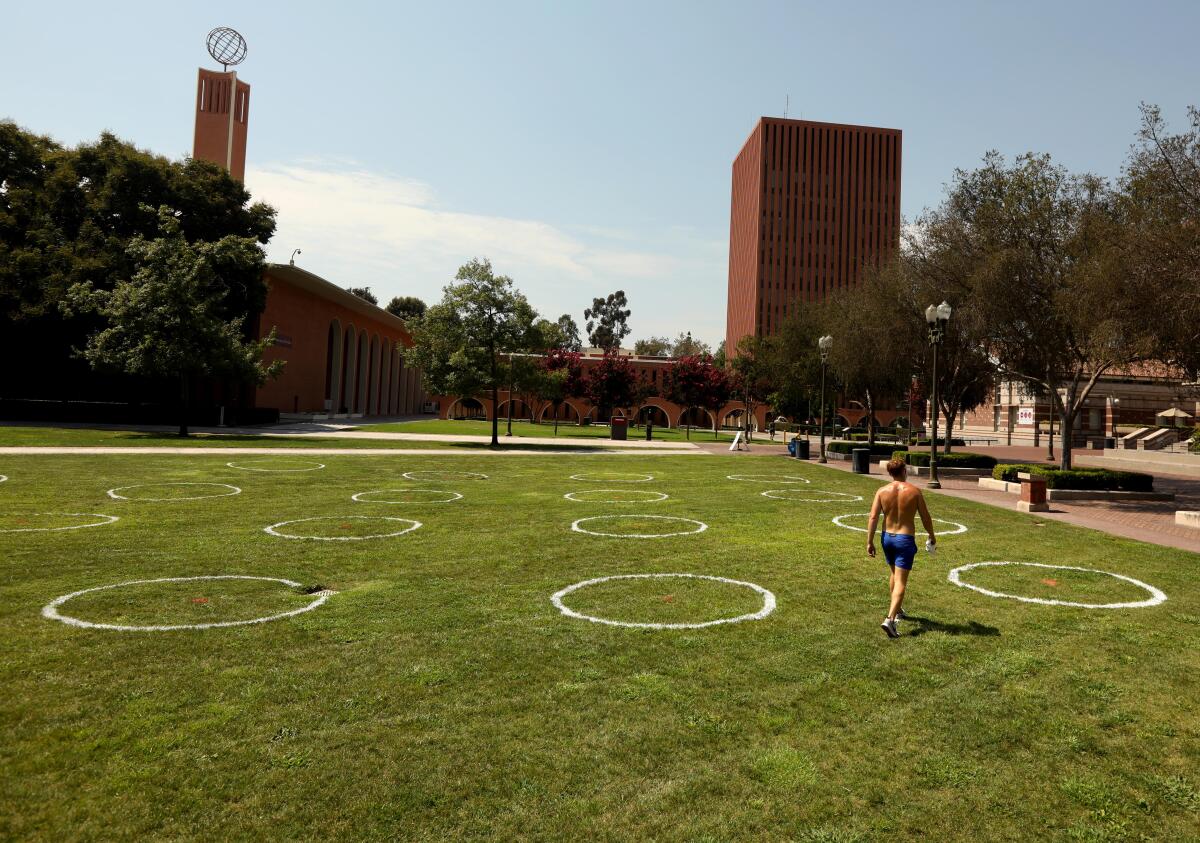
The L.A. County guidelines surpass those of the state, which allows double-occupancy dorms with safe distancing and masking. The county allows only students with no alternatives to live in campus-run housing. They also are stricter than many other counties, which are allowing colleges in their areas to open more extensively. Cal Poly San Luis Obispo, for instance, won its county approval for a plan to allow up to 5,980 students in on-campus housing — 70% of capacity.
Reopening plans for Cal Poly Pomona and Cal State Los Angeles both adhere to county rules. Cal Poly Pomona will offer housing to a maximum of 500 students, who will be housed in single-occupancy dorms with single restrooms. Priority will be given to students from other countries, former foster youth program participants, those experiencing housing insecurity or who were identified by the Disability Resource Center, among others.
Cal State Long Beach will house a maximum of 480 high-need students in single-occupancy dorms, while Cal State L.A. was asked for housing by only 80 students. Cal State L.A. will offer only in-person nursing classes.
More to Read
Sign up for Essential California
The most important California stories and recommendations in your inbox every morning.
You may occasionally receive promotional content from the Los Angeles Times.
